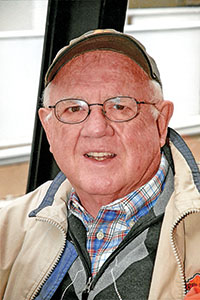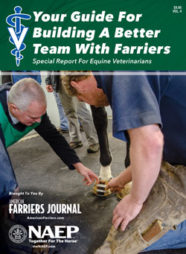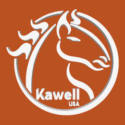Starting any career is no easy task and that’s certainly the case for new horseshoeing school graduates. After a few weeks or months of schooling on the equine foot, you’ll quickly realize that you don’t have all the answers or the confidence needed to succeed.
That’s why we’re sharing the thoughts from three recent graduates on how they overcame key obstacles in launching their hoof-care careers.
Each began a full-time shoeing career after graduating from horseshoeing school in 2005 and has already earned certified journeyman farrier status from the American Farrier’s Association (AFA). The three were recognized with a “Rising Shoeing Star” award at the February 2009 International Hoof-Care Summit.
This program is designed to promote the importance of further horseshoeing education while encouraging young shoers to be successful. This award program is co-sponsored by Anvil Brand Shoe, Co., G.E. Forge & Tool, Life Data Labs, Delta Mustad Hoofcare Center, Vettec, Victory Racing Plate Co. and American Farriers Journal.
Q: What were the major obstacles you faced in getting started?
Caldwell: Establishing a balance between family and work was tough. It meant determining what I needed to earn to reach my desired standard of living.
It seemed like I always wanted to buy two tools at every clinic, but that didn’t make financial sense.
I worked out of the back of my truck since I already had the vehicle, but then tried a shoeing trailer. Eventually, I went back to using only the truck with a used topper shell.
Whitt: The amount of education graduates receive and comprehend can be both a plus and a minus. The amount of information the schools present in 8 or 12 weeks is certainly an overload, and it’s hard to soak in all that information in such a short time. It’s easy to come out of school thinking you know too much when you really don’t know much of anything.
Pricing was another obstacle. I tried to stay in the “middle of the road” and not be over priced for my level of expertise. I didn’t want to be the cheapest farrier in town or be so over priced that I couldn’t back up my price with my ability.
Buying tools and equipment was another concern. I asked many questions and got opinions from different shoers. While you’ll get pluses and minuses on everything, it will help you make a better decision and save dollars in the long run.
Green: Getting started financially is a concern. But take your time, even though apprentices don’t make many dollars. Many grads find it is difficult to get started without working another job. Developing a client base, getting your name out there and being known for quality work is important.

Mike Caldwell of Paso Robles, Calif., a graduate of the Heartland Horseshoeing School in Lamar, Mo.

Keith Green of Wakeman, Ohio, a graduate of the Danny Ward Horseshoeing School in Martinsville, Va.

Robert Whitt of Phelan, Calif., a graduate of the Sierra South Horseshoeing School in Ramona, Calif.
Q: How did you spend the first 6 months after graduation?
Whitt: I worked with three different farriers, as well as independently. I attended every clinic and competition I could to get as much education as possible.
Green: I apprenticed several days a week with two outstanding farriers and still spend each Monday working with one of them to continue learning while I’m collecting some dollars. I’d shod a few horses before going to shoeing school, so I was able to get a good start with clients.
One farrier I apprenticed with wasn’t willing to give me any horses of my own until I was capable of being an AFA certified farrier. So I spent a lot of time making shoes, perfecting my forging skills, making mistakes and correcting them.
Caldwell: I apprenticed a couple days a week with a farrier for 2 years before going to shoeing school, and for another year after graduation. I did this while working a full-time job.
Q: Looking back, what were the three biggest mistakes you made? How can others avoid these problems?
Green: I got into a barn where feet were not a big priority, ran into a laminitc horse, didn’t know what to do and plunged in with disastrous results. It’s easy to get in over your head, so stay away from the nasty horses, although it’s not always easy when getting started.
When you need help on a horse, call the person you apprenticed with as he or she can offer good advice and save your butt. This is another reason why networking is so importan once you leave school.
Caldwell: I was spending too much time on the road by not scheduling nearby clients on the same day. Another problem was being unprepared to handle both the client and financial paperwork, including tracking expenses and income. I didn’t realize how much the taxes would be for being self-employed.
Unfortunately, I felt I had to have the best brands of tools, but money was tight. My first apron was a gift from a farrier. Instead of paying $75 to $100 for a new one, I had this apron repaired for $15.
Whitt: My biggest mistake was working part-time as an apprentice instead of tackling a full-time apprenticeship. I needed to support a family and was not making many dollars as an apprentice, but I let that control my learning.
If I had it to do over, I wouldn’t have taken on new clients as quickly and scheduled my own work only after finishing a day of apprenticing. Sometimes, I would pass up a full day of valuable learning with another farrier while trying to figure it out on my own.
I was hurting for money, so I’d take on work above my ability. While I learned a lot from each situation, I’m not sure I always made the best choices for the horses.
Find the best farrier in your area for an apprenticeship and beg and plead to work with them. Show them how much you want this and dedicate yourself to learning what they have to offer.
Working with just anyone isn’t always best. You may get under a lot of horses, but you may not always be learning.
Q: What were the three smartest moves you made in getting started?
Whitt: Attending clinics and competitions have been among my greatest rewards. I learn a great deal not only from the events, but also from networking with top farriers. Try not to isolate myself from more learning and take advantage of every opportunity to learn from other shoers.
Another good move was pursuing AFA certification. This made me work harder in the fire, spend more time with my nose in textbooks and seek help from the best farriers around.
My best move was going to England for 3 months as part of the AFA Cultural Exchange Program. This was an intense learning experience.
Caldwell: It was being able to tell a client that what his or her horse needed was out of my league, asking trusted farriers for advice and adjusting my schedule to work with vets.
Green: Two outstanding farriers who were great teachers let me apprentice with them. I still work a day a week with one of them.
Get started on getting certified as the learning is important for your career growth. The biggest benefit is not whether you become certified, but the knowledge you gain and the skills you develop along the way.
Making handmade shoes quickly teaches you what shoeing is all about. When you make a shoe that can’t be nailed on, you start learning real quick. This handmade experience also helps you become much more efficient at the anvil when shaping keg shoes.
Q: What other suggestions do you have for graduates?
Caldwell: Be willing to accept criticism from other farriers and vets. Enter competitions and go to as many clinics as possible. Keep a humble attitude. Get involved with a local farrier association. Join the AFA and set a goal of becoming a certified journeyman farrier.
Among all the horses I shoe each week, I play a little personal game and decide which was the best shod. For me, this exercise is like entering a weekly live shoeing competition and is something I do to keep striving to get better.
Green: Establishing a reputation for doing quality work is more important than going fast and possibly making mistakes. You may get razzed for being slow, but you shouldn’t lose any customers because of taking your time and doing the best job possible. Be more concerned with the quality of your work than the quantity.
Learn all you can about horses, be seen at local horse shows and talk with horse people. This is very important as you learn about new disciplines and different trimming and shoeing needs. I grew up on a 2,000-acre crop operation and had a background with horses, but someone who hasn’t previously been around horses will have to work much harder at developing the needed horsemanship skills.
A thorough knowledge of horses is essential for success as a farrier. Your clients expect you to know much more about horses than just about the feet. ?







